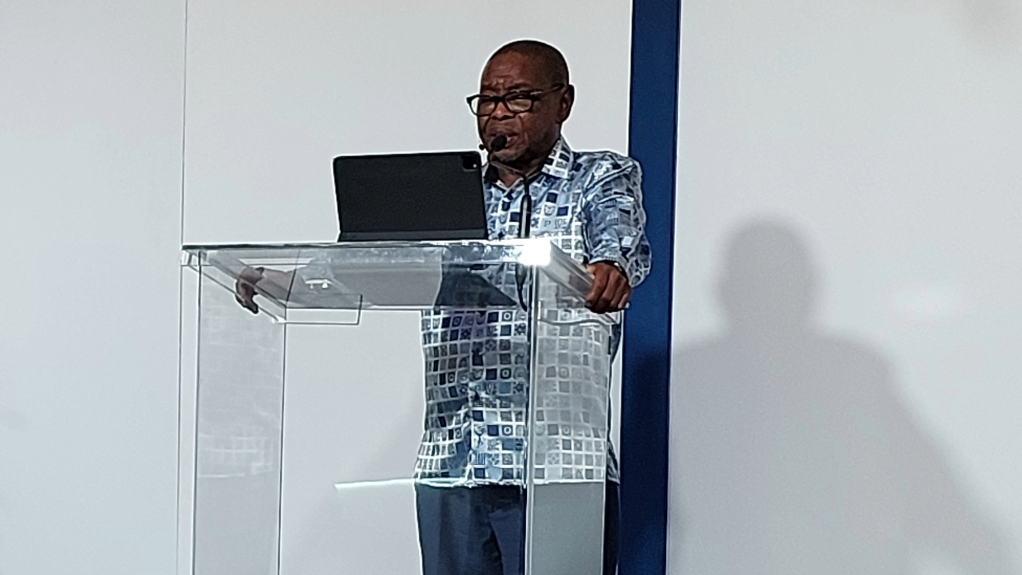CSIR launches enterprise to commercialise first set of 18 technologies


CSIR CEO Dr Thulani Dlamini discusses the council's new IP commercialisation enterprise. Video and editing: Nicholas Boyd.
Science and Innovation Minister Dr Blade Nzimande
The Council for Scientific and Industrial Research (CSIR) has launched its intellectual property (IP) commercialisation enterprise CSIR C-Cubed (CSIR C3) with a portfolio of 18 technologies and it is looking for business partners, entrepreneurs and investors to help it commercialise them and have a positive impact on society and the economy.
The CSIR's contribution to industrial development happens in two ways, firstly through research, development and innovation, and collaboration with existing enterprises. The second way is through the translation of IP into viable enterprises, CSIR CEO Dr Thulani Dlamini said at the launch of CSIR C3 on October 25.
"Over the past four years of licensing our IP, we have signed 30 technology licence agreements with the private sector. However, we believe there is significant room to improve in this area and we understand the huge potential this has to transform our country and the future of the CSIR," he said.
Over the past four years, it enabled 110 localisations through joint technology developments with industry, supported 427 small and medium-sized enterprises (SMEs) and had 92 staff exchanges with industry, he noted.
"To achieve our goals and the impact we want to see, we have adopted an approach of creating a dynamic ecosystem of willing partners with shared values seeking mutual benefits," he said.
"Commercialisation of IP is not just about financial resources, but about creating an ecosystem of the critical elements, including facilities required for incubation and to accelerate technology development and innovation."
CSIR C3's success will rest on three main components, namely a strong IP portfolio, entrepreneurs with sharp business acumen and a network of investors along the full value chain of commercialisation, said Dlamini.
"CSIR C3 represents the intention to collaborate, create and commercialise technologies, but, more importantly, is an intentional response to help address the three main social challenges of poverty, unemployment and inequality," he said.
TECH PORTFOLIO
The 18 technologies released in the inaugural CSIR C3 prospectus were selected based on their market attractiveness and technological maturity, and all of them were anchored with patents and some were technology packages, or designs for subsystems, systems and plants, while some were services and service models opportunities, said CSIR advanced chemistry and life sciences group executive Dr Rachel Chikwamba.
In the health portfolio, the CSIR C3 includes a genetic liver screening service that will help to develop medicines that are safe for use based on people's genetic makeup. Further, the company also has a cellphone-based infectious disease detection system without the need for a laboratory, she illustrated.
"Also in the portfolio are a range of antibodies that our researchers have developed that can serve as active pharmaceutical ingredients, including for biotechnology-based medicines, which is the fastest growing category in the pharmaceuticals market. The prospectus includes a portfolio of antibodies and the methods to make them, which can lead to a suite of businesses leveraging them for different purposes," she noted.
The manufacturing technologies portfolio includes a process to make biodegradable plastics, processes to manufacture lactic acid for use in foods and cosmetics, and advanced metal additive manufacturing systems.
Further, CSIR C3's portfolio also included a green cement technology, and there was a prototype and the manufacturing process available for potential partners, said Chikwamba.
Additionally, the company had Earth observation technologies that it was using to create observation services for farmers in real-time so that they always knew the state of play on their farms, and some of the information included areas where the crop density was low and whether the crops were growing at the rate expected, she added.
Other Earth observation technologies included synthetic aperture radar that could be used in border control and disaster management applications, while the advanced phased array antenna technology could support short- and long-term weather forecasting, she said.
The CSIR also had defence and public safety technologies in the portfolio, and could help to revitalise the defence industry, which was an important contributor to the manufacturing sector, she said.
The defence technologies include ground surveillance radar to aid situational awareness, which also presents opportunities for safeguarding infrastructure or animals in game parks, and an armoured vehicle turret designed to protect the user in the theatre of war.
"While the economy is not easy now, we need entrepreneurs and brave individuals to take these technologies and services and provide them to the market," she said.
Meanwhile, the prospectus is only the first of many envisaged, with the next portfolio of technology development opportunities expected to be released in three to six months. CSIR C3 has an evergreen pipeline of inventions stemming from the research conducted by the institution, and has created this business to commercialise its technologies.
"We have a significant war chest of research, development and innovation to feed into the business and we need takers who can shepherd these solutions to market," Chikwamba said.
"There can be no industrial development without innovation. The launch [of CSIR C3] is a significant milestone in South Africa's science, technology and innovation journey and is part of the ten-year science, technology and innovation plan to 2031," said Higher Education, Science and Innovation Minister Dr Blade Nzimande.
"CSIR C3 is a key platform for building public-private partnerships that are central to driving the science, technology and innovation agenda in South Africa. Technology commercialisation can contribute enormously to economic transformation through the introduction of diverse new products, services and new industries in the South African economy," he said.
The creation of new products can lead to new businesses that can serve as the basis for full-scale localisation and industrialisation, and science, technology and innovation are central in achieving these two objectives.
"Without science, technology and innovation, we cannot really grow and develop our economy. The [Department of Science and Innovation] considers science, technology and innovation as a primary driver of economic growth, job creation and socioeconomic change in the country.
"Science, technology and innovation are important components of the means of production in all societies and can support the development of major economic sectors," Nzimande said.
Further, science, technology and innovation were not just about big businesses, but also about SMEs that could drive technologies by using them, he noted.
Article Enquiry
Email Article
Save Article
Feedback
To advertise email advertising@creamermedia.co.za or click here
Comments
Press Office
Announcements
What's On
Subscribe to improve your user experience...
Option 1 (equivalent of R125 a month):
Receive a weekly copy of Creamer Media's Engineering News & Mining Weekly magazine
(print copy for those in South Africa and e-magazine for those outside of South Africa)
Receive daily email newsletters
Access to full search results
Access archive of magazine back copies
Access to Projects in Progress
Access to ONE Research Report of your choice in PDF format
Option 2 (equivalent of R375 a month):
All benefits from Option 1
PLUS
Access to Creamer Media's Research Channel Africa for ALL Research Reports, in PDF format, on various industrial and mining sectors
including Electricity; Water; Energy Transition; Hydrogen; Roads, Rail and Ports; Coal; Gold; Platinum; Battery Metals; etc.
Already a subscriber?
Forgotten your password?
Receive weekly copy of Creamer Media's Engineering News & Mining Weekly magazine (print copy for those in South Africa and e-magazine for those outside of South Africa)
➕
Recieve daily email newsletters
➕
Access to full search results
➕
Access archive of magazine back copies
➕
Access to Projects in Progress
➕
Access to ONE Research Report of your choice in PDF format
RESEARCH CHANNEL AFRICA
R4500 (equivalent of R375 a month)
SUBSCRIBEAll benefits from Option 1
➕
Access to Creamer Media's Research Channel Africa for ALL Research Reports on various industrial and mining sectors, in PDF format, including on:
Electricity
➕
Water
➕
Energy Transition
➕
Hydrogen
➕
Roads, Rail and Ports
➕
Coal
➕
Gold
➕
Platinum
➕
Battery Metals
➕
etc.
Receive all benefits from Option 1 or Option 2 delivered to numerous people at your company
➕
Multiple User names and Passwords for simultaneous log-ins
➕
Intranet integration access to all in your organisation
















